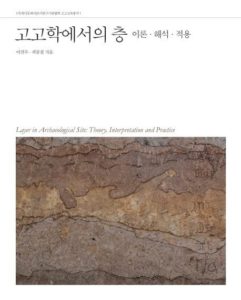
Kwak Jong Chul and Lee Jin Ju
Seoul: Sahoepyeongnon (The Social Review) 사회평론, 2012
Reviewed by Youngbae Ji (Mesoamerica Archaeology Training Program Fellow)
This book describes stratigraphy—an essential tool and standard for archaeological excavations—in both scholarly and practical terms. At excavation sites, many researchers are not only hesitant but also confused about the subjectivity surrounding the interpretation of layers. This book helps to solve this problem by providing details about archaeological stratigraphy and its components, which improves the efficiency of excavation when applied to an archaeological site. The best merit of this book is its marvelous photos and drawings from archaeology, geology, sedimentology, quaternary research, and soil science, which further helps readers to understand more about the branches of study in archaeological stratigraphy. On this basis, the book was selected as the 2013 “Great Academic Literature” in Korea.
The book consists of three chapters. Chapter 1 and Chapter 2 are about alluvion sites and features. Specifically, Chapter 1 describes the importance, components, and division of archaeological stratigraphy. Chapter 2 goes on to define the concepts, principles, and elements of stratigraphy and provides the reader with archaeological cases. Additionally, the author introduces the appropriate case by filling in the layer and dating of the stratigraphy. Chapter 3 describes the layering of the features at mountain and hill sites and moreover, the suggested contents and kinds of layers in the features at archaeological sites. The author introduces and interprets some principle feature cases of function in archeological sites. Moreover, the “life cycles” of features are reestablished by using layers in the features. The life cycle of a feature is in its construction, use, destruction, burial cycle and discovery by the archeologist in the sites.
The most helpful aspect of this book, from my own experience at archaeological sites, was its explanation of the changing color and particles of soil, which exposed surface soil in the stratigraphy. The book explained that within one layer in the stratigraphy we can divide and make a layer set ‘a’ and ‘b’; the already changed soil is Layer ‘a,’ and the not transited soil part of the layer is Layer ‘b.’ This method may be used to arrange the stratigraphy of sites, and was first used by the geologist Takahashi. There were some errors in the interpretation of the stratigraphy when they divided the layers with almost the same soil component, with only the color remaining different. Primarily, this method is valuable for using the technique of Layer ‘a’ and ‘b,’ which makes it easy to check and interpret the flow of the stratigraphy at a large alluvion site.
This book raised many big issues when first published in Korea. Many archaeologists sympathized with the problem of the stratigraphy in the site. Furthermore, this book became an excellent textbook on agriculture sites, which it regarded as the most difficult excavations in South Korea. Subsequently the book was frequently used in seminars on stratigraphy in the field by the Korean Association for Archaeological Heritage and other Korean archaeological research institutes. I highly recommend this book for archaeologists who are conducting an excavation to use this book on site. Furthermore, this book might be used to help students to better understand archaeological sites.
